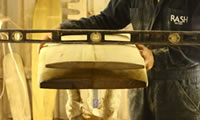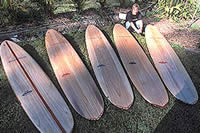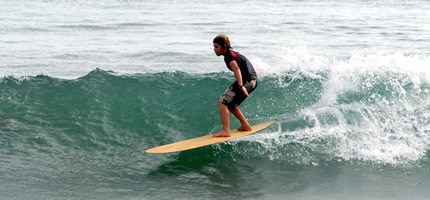Tom Wegener Interview
If you have seen Tom Wegener in Siestas & Olas you’ll know that he surfs some heavy waves on huge boards. Tom is a respected surfer and has inspired the likes of Joel Tudor and countless others with his classic style. But Tom is also a master shaper and designer. His design philosophy and choice in materials has been causing a stir in the surfing world. Tom took a few minutes of his time to talk with Phoresia.org about Permaculture, sustainability, and the essence of the surfing experience. Be sure to check out Tom’s articles on design and history at Wegener Surfboards.
…………………………………………………………………………..
Q. When I saw you mulching your trees with the shavings from your shaping room in the movie Sprout I immediately made a connection with Permaculture. Has living in Australia, the birthplace of Permaculture, inspired your work?
The Permaculture crew around here is big and they are amazing! We are slowly transforming our property into a micro farm and looking to them for guidance. I grew up in Los Angeles and had little contact with the land. Now I have the opportunity to see how things grow and the immense difference working in tune with the land makes.
This is sort of a crazy example, but a hippie lives near and he helps me choose where to plant the trees. He can feel the underground water movement, (and I can too with a bent piece of metal wire) and he teaches me how to plant or build things in accordance to them. If you ask the earth where to plant a tree it will tell you.
Living in harmony with these forces of nature, though invisible to the eye, has proven to me to make a difference to the plants and to us. I am just beginning to learn and there really is a lot to learn! Many things like the above example seem really trippy to me. Also, living that way takes a mighty effort and is a never ending job. But it appears that the rewards are worth the effort.
Q. Sustainability is a tricky word. It can be seen in all types of publications these days and often the meaning is blurred. What does sustainability mean to you and how do you think it can be applied to the general surf industry?
I think of respect as being almost synonymous with sustainability. If you respect something you do not squander or neglect it.
For years I was a team rider for Donald Takayama. I would get a brand new surfboard andI would want to keep it forever. But, by the time I got tuned  into a new board, it would start getting stress fractures and the deck would start caving in. I respect Takayama’s shapes so much that I thought it was criminal that the board would deteriorate. The Clark Foam era of surfboards was at a low point in surf history and the ultimate in un-sustainability. When a master craftsman makes something it should last a long time.
into a new board, it would start getting stress fractures and the deck would start caving in. I respect Takayama’s shapes so much that I thought it was criminal that the board would deteriorate. The Clark Foam era of surfboards was at a low point in surf history and the ultimate in un-sustainability. When a master craftsman makes something it should last a long time.
The key part of sustainability for surfboards seems more toward making a board that will last as well as surf very well.
Q. Surfing can be done on any type of board —whether prone, or standing, or on your knees, or even without a board at all. The feeling of being on a wave is what moves us internally and keeps most us coming back to it. The lifestyle and fashion and type of surfboard that we use seems to be more motivated by industry than by the inherent act of surfing. Do you think that the act of surfing has become overly commercialized? Do you see a future where the act is more important than the things that come with it?
I think surfing has been over commercialized for a long time. It seems odd that surfers like to think of themselves as rebellious, however, it seems obvious that it is a very conformist culture. I have always experimented with different equipment and I have copped an amazing amount of flack from people doing the “in” thing. I remember reading Sam George in Surfer Magazine ranting against the growing popularity of longboarding in the late 1980s. I was just amazed. At that time I was longboarding virtually empty Malibu, San Onofre and Cardiff Reef on vintage longboards that I bought for basically spare change.
 In a way, the tight conformity of the masses offers great opportunities to surf empty surf that they are not interested in. I have been riding longboards from 12 to 18 feet this year and having a great time in surf that is out of bounds for normal surfing. Also, the Alaia opens lots of great waves that are not much fun on finned boards. I enjoy surfing in crowds, but I have to balance it with long, soul searching sessions by myself. The different boards offer a balance.
In a way, the tight conformity of the masses offers great opportunities to surf empty surf that they are not interested in. I have been riding longboards from 12 to 18 feet this year and having a great time in surf that is out of bounds for normal surfing. Also, the Alaia opens lots of great waves that are not much fun on finned boards. I enjoy surfing in crowds, but I have to balance it with long, soul searching sessions by myself. The different boards offer a balance.
J. Paul Getty said that the only time he was truly happy was when he was playing in the surf as a kid. Just playing in the surf is so much fun. The whole obsession with equipment doesn’t seem to add much to enjoyment. I love my little slabs of wood to help me angle across a wave (The Alaia).
Q. I think many of us are quite unfamiliar with wooden surfboards. I myself have never ridden one, and the only type I’ve seen are the solid balsa longboards. Do you think that in the future wooden boards will play a larger role in the industry?
Wood is here to stay. First, it gives a great feeling when on the wave. You just have to experience it. Second, there are lots of ways to make wood boards inexpensively in your garage. I am seeing a quiet revolution happening where lots of people are going back to making their own equipment.
Back to how conservative surfers are, it was gospel that balsa and redwood were the only wood for surfboards. This stifled wood board design since the 1960s. I now know there are lots of other woods. The Paulownia I use is the best that I have found, but there may be even better woods.
I think the next jump in the wood board revolution will be when the garage wood board builders get better at joining the wood together and make them water tight so they do not have to be glassed. Glassing is such a bummer. Oiled wood moves through the water better and the glass is just dead weight on the board. My solid Alaia boards are just oiled and they feel great! I have pursued the un-glassed hollow board now for a year and I have made seven of them. There are some problems and I am constantly working out the bugs. Soon I will be making a DVD with a few different approaches to making these boards.

14 year old Keahe standing on one of Wegener’s laydown boards.
Q. You have been an inspiration for us here at phoresia.org. I think that maybe you inspire many people who are seeking to simplify what surfing means to them. Any words of wisdom that you’d like to leave us with?
Try an Alaia!!!! Just get a piece of plywood or glue together some fence posts and give the ancient style a chance.
I saw a 12 foot Tom Wegener in the lineup at Swamis Friday. Beautiful nose and tail blocks and fin. The whole thing was amazing. I wanted to ride it so bad… :D
i saw that quote by J Paul Getty. Amazing, coming from one of the world’s wealthiest men at the time – something so simple is what he remembers as bringing him true happiness.
Man ive been a carpenter for 25 years and a shaper for 15 years and it took clark to close for me to look at finaly putting the two together, ive been drawn to making wooden boards for a while but finaly feel now I have too.I live in North Carolina but travel between hawaii and panama and am wondering if there are any lumber yards with olo sized planks 16′ or so. any help? aloha spear
I remember when a surfboard a pair of trunks, and a bar of parafin wax was all a surfer needed to go surfing. When the surf blew out we body surfed or went diving. I went in the Army in 1966. In the 3 years I was gone, leashes, wetsuits, a bunch stickers, and wax that smelled like perfume was required to go surfing. Gone was the kickout. Leashes made it not necessary to even know how to swim. 40 years ago, if you surfed, you had many ocean oriented activities and a surfboard was just part of your equipment that included a sqear gun, fins and a fishing pole. Too many surfers today rely on a wetsuit for floatation, a leash to keep their board close by, and a computer to tell them when to go to the beach. I miss the old days. Wood boards, single fins, sounds good to me.
Hang Ten
Jim